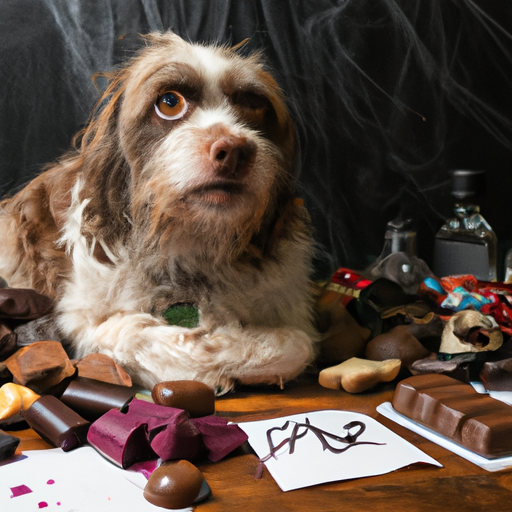Chocolate, the sweet treat that humans often indulge in, can pose a significant threat to our canine companions. Understanding the risks and identifying the signs of chocolate toxicity can be a vital factor in ensuring the health and wellbeing of your pet.
What Makes Chocolate Poisonous to Dogs?
The primary culprits in chocolate that are harmful to dogs are theobromine and caffeine. Both of these compounds are stimulants that can speed up your dog’s heart rate and stimulate their nervous system. This can lead to a variety of symptoms, including restlessness, increased urination, tremors, and in severe cases, seizures.
The amount of theobromine and caffeine varies based on the type of chocolate. Here’s a quick overview:
| Type of Chocolate | Theobromine per 1 oz. | Caffeine per 1 oz. |
|---|---|---|
| Milk Chocolate | 60 mg | 6 mg |
| Dark Chocolate | 160 mg | 20 mg |
| Baker’s Chocolate | 393 mg | 47 mg |
| Cocoa Powder | 737 mg | 70 mg |
How Much Chocolate is Too Much?
The amount of chocolate that can be harmful to your dog depends on three factors:
- The type of chocolate
- The weight of your dog
- The overall health of your dog
As a rule of thumb, smaller dogs are at a higher risk because a small amount of chocolate can constitute a large dose for them. Dogs with existing health conditions may also be more susceptible.
However, it’s crucial to note that no amount of chocolate is safe for dogs. Even a small piece can cause an upset stomach, while larger amounts can lead to severe complications.
Recognizing Symptoms of Chocolate Poisoning
If your dog has ingested chocolate, they may exhibit several symptoms:
- Restlessness
- Increased urination
- Rapid breathing
- Tremors
- Vomiting
- Diarrhoea
In severe cases, your dog may experience seizures, heart failure, and in rare cases, death. If you notice any of these symptoms, contact your vet immediately.
What to Do if Your Dog Ingests Chocolate
Knowing what to do when your dog has eaten chocolate can be the difference between life and death.
- Act quickly: The sooner you act, the better the chances of your dog recovering.
- Contact your vet: They can provide guidance based on the amount and type of chocolate ingested and the size and health of your dog.
- Do not induce vomiting without veterinary advice: While it can help in some cases, it can also cause other problems.
- Keep chocolate out of reach: Prevention is the best cure. Always store chocolate in a secure place where your dog can’t reach it.
FAQ
Q: Can white chocolate harm dogs?
A: While white chocolate contains lower levels of theobromine, it can still cause an upset stomach and pancreatitis due to its high fat and sugar content.
Q: What if my dog only ate a small piece of chocolate?
A: Even a small amount can cause an upset stomach. If your dog ingests any chocolate, it’s always best to consult your vet.
Q: Can dogs develop a tolerance to chocolate?
A: No, dogs can’t develop a tolerance to chocolate. Repeated exposure can lead to more severe reactions, not less.
Q: Is there a specific treatment for chocolate poisoning in dogs?
A: Treatment usually involves inducing vomiting, administering activated charcoal to absorb the toxins, and providing supportive care.
Q: Can cats eat chocolate?
A: No, chocolate is also toxic to cats, although most cats won’t eat it due to their taste receptors.
Remember, when it comes to dogs and chocolate, it’s always better to be safe than sorry. Keep your furry friends safe by keeping chocolate out of their reach.



